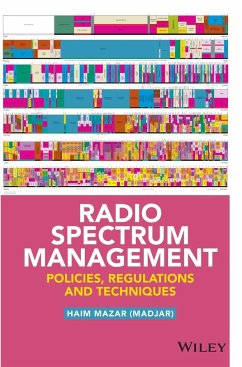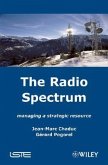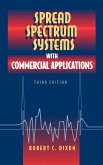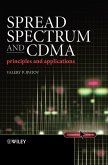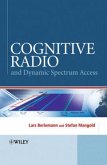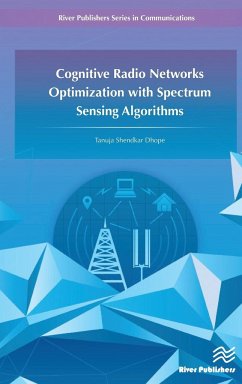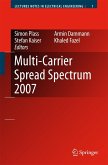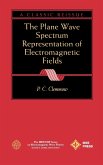- Gebundenes Buch
- Merkliste
- Auf die Merkliste
- Bewerten Bewerten
- Teilen
- Produkt teilen
- Produkterinnerung
- Produkterinnerung
This book presents the fundamentals of wireless communications and services, explaining in detail what RF spectrum management is, why it is important, which are the authorities regulating the use of spectrum, and how is it managed and enforced at the international, regional and national levels. The book offers insights to the engineering, regulatory, economic, legal, management policy-making aspects involved. Real-world case studies are presented to depict the various approaches in different countries, and valuable lessons are drawn. The topics are addressed by engineers, advocates and…mehr
Andere Kunden interessierten sich auch für
![The Radio Spectrum The Radio Spectrum]() Jean-Marc ChaducThe Radio Spectrum197,99 €
Jean-Marc ChaducThe Radio Spectrum197,99 €![Spread Spectrum Systems with Commercial Applications Spread Spectrum Systems with Commercial Applications]() Robert C DixonSpread Spectrum Systems with Commercial Applications242,99 €
Robert C DixonSpread Spectrum Systems with Commercial Applications242,99 €![Spread Spectrum and Cdma Spread Spectrum and Cdma]() Valeri P IpatovSpread Spectrum and Cdma154,99 €
Valeri P IpatovSpread Spectrum and Cdma154,99 €![Cognitive Radio and Dynamic Spectrum Access Cognitive Radio and Dynamic Spectrum Access]() Lars BerlemannCognitive Radio and Dynamic Spectrum Access120,99 €
Lars BerlemannCognitive Radio and Dynamic Spectrum Access120,99 €![Cognitive Radio Networks Optimization with Spectrum Sensing Algorithms Cognitive Radio Networks Optimization with Spectrum Sensing Algorithms]() Tanuja S DhopeCognitive Radio Networks Optimization with Spectrum Sensing Algorithms105,99 €
Tanuja S DhopeCognitive Radio Networks Optimization with Spectrum Sensing Algorithms105,99 €![Multi-Carrier Spread Spectrum 2007 Multi-Carrier Spread Spectrum 2007]() Simon Plass / Armin Dammann / Stefan Kaiser / K. Fazel (eds.)Multi-Carrier Spread Spectrum 2007112,99 €
Simon Plass / Armin Dammann / Stefan Kaiser / K. Fazel (eds.)Multi-Carrier Spread Spectrum 2007112,99 €![The Plane Wave Spectrum Representation of Electromagnetic Fields The Plane Wave Spectrum Representation of Electromagnetic Fields]() P C ClemmowThe Plane Wave Spectrum Representation of Electromagnetic Fields150,99 €
P C ClemmowThe Plane Wave Spectrum Representation of Electromagnetic Fields150,99 €-
-
-
This book presents the fundamentals of wireless communications and services, explaining in detail what RF spectrum management is, why it is important, which are the authorities regulating the use of spectrum, and how is it managed and enforced at the international, regional and national levels. The book offers insights to the engineering, regulatory, economic, legal, management policy-making aspects involved. Real-world case studies are presented to depict the various approaches in different countries, and valuable lessons are drawn. The topics are addressed by engineers, advocates and economists employed by national and international spectrum regulators. The book is a tool that will allow the international regional and national regulators to better manage the RF spectrum, and will help operators and suppliers of wireless communications to better understand their regulators.
Hinweis: Dieser Artikel kann nur an eine deutsche Lieferadresse ausgeliefert werden.
Hinweis: Dieser Artikel kann nur an eine deutsche Lieferadresse ausgeliefert werden.
Produktdetails
- Produktdetails
- Verlag: John Wiley & Sons / Wiley
- Seitenzahl: 448
- Erscheinungstermin: 29. August 2016
- Englisch
- Abmessung: 250mm x 175mm x 29mm
- Gewicht: 952g
- ISBN-13: 9781118511794
- ISBN-10: 1118511794
- Artikelnr.: 43757831
- Herstellerkennzeichnung
- Libri GmbH
- Europaallee 1
- 36244 Bad Hersfeld
- gpsr@libri.de
- Verlag: John Wiley & Sons / Wiley
- Seitenzahl: 448
- Erscheinungstermin: 29. August 2016
- Englisch
- Abmessung: 250mm x 175mm x 29mm
- Gewicht: 952g
- ISBN-13: 9781118511794
- ISBN-10: 1118511794
- Artikelnr.: 43757831
- Herstellerkennzeichnung
- Libri GmbH
- Europaallee 1
- 36244 Bad Hersfeld
- gpsr@libri.de
Dr Haim Mazar (Madjar) Haim Mazar has more than 40 years of experience in regulatory activities, wireless communications, broadcasting and spectrum management. He received a BSc is in electrical engineering from the Technion, Haifa, Israel in 1971; an MBA from Bar-Ilan University in 1988; and a PhD from Middlesex University, London, UK in 2008, focusing on regulatory frameworks for wireless communications.
About the Author xiii Foreword xiv Preface xv Acknowledgments xviii Acronyms and Abbreviations xxi 1 The Radio Frequency Spectrum and Wireless Communications 1 1.1 Historical Overview 1 1.2 A General Communication Channel 2 1.3 Radio Frequency Bands 2 1.4 Scarcity of the RF Spectrum 3 References 4 2 The Main Regulated Radio Services 5 2.1 General 5 2.2 Terrestrial Broadcasting Delivery: Sound (Radio) and Video (Television) 6 2.2.1 Definitions and Introduction 6 2.2.2 Broadcasting Video and Audio Delivery 8 2.2.3 Terrestrial Sound (Audio) 10 2.2.4 Terrestrial Video (Television) 14 2.3 Land Mobile and the Cellular Service 25 2.3.1 Definitions and Introduction 25 2.3.2 Cellular Reference Network Unit 26 2.3.3 Regulation and Standardization of the Cellular Service 28 2.3.4 IMT Terrestrial Radio (Including LTE) 33 2.4 Fixed Point
to
Point and Point
to
Multipoint 38 2.4.1 Overview of Fixed Services: Fixed Networks and Mobile Backhauling 38 2.4.2 Deployment and Performance 39 2.4.3 Line
of
Sight (LoS) and Non
Line
of
Sight (NLoS) Links 43 2.4.4 Fixed Wireless Systems (FWS) and Broadband Wireless Access (BWA) Systems 44 2.4.5 Available RF Spectrum and Frequency Planning 45 2.5 Satellite Communications 47 2.5.1 Definitions of Satellite Communications 47 2.5.2 Satellite Orbits and Services 47 2.5.3 Satellite Equipment 62 2.5.4 Monitoring and Regulating Satellite Communications 65 References 69 3 Short Range Devices and the License
Exempt RF Spectrum 72 3.1 Regulatory Framework of SRDs 72 3.1.1 Definitions and Applications 72 3.1.2 Non
Interference, Unlicensed and Unprotected 73 3.1.3 Mutual Agreements Between Countries/Regions 75 3.1.4 Placing the SRD on the Market and the Labeling of SRDs 75 3.1.5 SRDs Interfering with Radiocommunications Services 79 3.2 Collective Use of SRDs 80 3.2.1 Risk
versus
Risk 80 3.2.2 The Collectivized View Explaining the Harmonization of SRDs and the RF 81 3.2.3 The Individualized View Explaining Minimal Restrictions 81 3.3 An Engineering Background to Understand the SRD Technical Parameters 82 3.3.1 Friis Equations, Received Power, Electric and Magnetic Field
Strengths: Numerical Equations 82 3.3.2 Received Power and Electric Field
Strength: Numerical Equations 83 3.3.3 Received Power and Magnetic Field
Strength: Numerical Equations 84 3.3.4 Received Power, Electric and Magnetic Field
Strength: Logarithmic Equations 84 3.4 Global Regulation of SRDs 86 3.4.1 Globalization 86 3.4.2 ISM BANDS: Extracts from ITU RR and Spectrum Management Recommendations 87 3.4.3 Frequency Ranges for Global or Regional Harmonization of SRDs 89 3.4.4 Technical and Operating Parameters and Spectrum Use for SRDs 91 3.5 Regional Regulation of SRDs 91 3.5.1 Region 1 and CEPT/ECC ERC Recommendation 70
03 92 3.5.2 Region 2 and the FCC CFR 47 Part 15 Radio Frequency Devices 93 3.5.3 Region 3: SRDs in APT Countries 96 3.6 Global and Regional Ruling in Three ITU Regions: Case Studies to Compare and Contrast 97 3.6.1 Case Study 1: Wi
Fi, RLAN, WLAN, U
NII 98 3.6.2 Case Study 2: RFID's Global and Regional Ruling 105 3.6.3 Case Study 3: ISM and the Citizen Band 26.96-27.28 MHz 108 References 110 4 Policies, Legal and Economic Frameworks to Manage the RF Spectrum 112 4.1 Worldviews Shape RF Policies 112 4.1.1 Culture, Regulation and Uncertain Risks 112 4.1.2 Central Planning (Ex
Ante and A
Priori) Versus Market
Based (Ex
Post and A
Posteriori) Approaches 115 4.1.3 Radio Frequency Regulatory Framework and Basic Objectives 118 4.2 Legal Environment 118 4.2.1 Two Different Legal Traditions: Civil Law and Common Law 118 4.2.2 The Legal Framework 120 4.2.3 Radiocommunications Law 122 4.2.4 Factors Affecting the RF Value 123 4.2.5 The RF Spectrum and Property Rights 123 4.2.6 International, Regional and National Legislation 124 4.3 The Economic Environment 126 4.3.1 Economics and Spectrum Management 126 4.3.2 Benefits of Using the Radio Spectrum 130 4.3.3 National Cost Accounting: The RF Spectrum as a Non
Produced Asset 133 4.3.4 Fee Policy 136 4.3.5 License Fee: Comparative Evaluation Methods, Auctions and Lotteries, Secondary Trading 138 4.3.6 RF Spectrum Annual Fees 143 4.4 International, Regional and National Frequency Allocation Table and Redeployment 146 4.4.1 Allocation Table 146 4.4.2 RF Spectrum Redeployment and Refarming 146 References 148 5 RF Engineering and the Link Budget 150 5.1 End
To
End Wireless Communication 150 5.2 RF Characteristics: Modulation and Multiple Access 151 5.2.1 Modulation and Digitization 151 5.2.2 Representation of the Modulated Signal 155 5.2.3 Analog Modulations 157 5.2.4 Digital Modulations 157 5.2.5 Channel Multiple Access and Full Duplex Techniques 165 5.3 Transmitters: Power and Unwanted Emissions 168 5.3.1 Transmitter Block Diagram 168 5.3.2 Emission Mask 169 5.3.3 Unwanted Emissions 169 5.4 Receivers: Concept, Selectivity, Noise and Sensitivity 172 5.4.1 Receiver Noise Floor and Sensitivity 172 5.4.2 Noise Factor and Noise Temperature 174 5.4.3 Gain to Noise Temperature G/T for Satellite Earth and Space Stations 176 5.5 Antennas: Fundamental Parameters 177 5.5.1 Antenna: Aperture, Beamwidth, Directivity and Gain 178 5.5.2 Three
Dimensional Radiation Pattern and Gain Calculations 182 5.5.3 Antenna Polarization, Bandwidth, Insertion Loss and Impedance 192 5.6 Propagation 194 5.6.1 General 194 5.6.2 Friis Transmission Equation and Free
Space Propagation Loss: Power 194 5.6.3 Maxwell's Equations and Received Free
Space Field
Strength from a Far
Field Emission 198 5.6.4 ITU
R P.1546 Propagation Curves 30-3,000 MHz 203 5.6.5 Fresnel Zones 204 5.6.6 Attenuation by Atmospheric Gases 206 5.6.7 Near
Field to Far
Field 206 5.6.8 Frequency Dependency in Penetrating Walls and Bypassing Obstacles 207 5.7 Link Budget 210 5.7.1 Power Equations 210 5.7.2 Conversion Formulae 212 5.8 Radio Frequency Interference and Spectrum Sharing 215 5.8.1 Non
Linear Interference 215 5.8.2 Linear Interference 217 5.8.3 Decreasing Interference: Mitigation Techniques 225 References 225 6 International RF Spectrum Management and Standardization 229 6.1 International Regulations and Standards 229 6.2 Regulation and Standardization 230 6.2.1 International RF Spectrum Management and Standardization Players 230 6.2.2 Worldwide Regulation and Standardization 234 6.2.3 Globalization of RF Regulation and Standardization 240 6.3 National, Regional and Global RF Regulation 242 6.3.1 Transfer of National Regulatory Power to an Intergovernmental Authority 242 6.3.2 Implementing Regional RF Spectrum Management and Standardization 244 6.4 Global Regulatory Framework: ITU 245 6.4.1 ITU
D (also Telecommunications Development Bureau, BDT) 246 6.4.2 ITU
T (also TSB, Telecommunication Standardization Bureau) 247 6.4.3 ITU
R (also BR, Bureau Radio) 247 6.4.4 ITU Radio Regulations 249 6.5 Cross
Border Coordination, Regulation and Techniques 256 6.5.1 Avoiding Harmful Interference between Administrations 256 6.5.2 Bilateral and Multilateral Agreements 256 6.5.3 Preferential Use of Frequencies, Trigger Levels and Distance from the Border 257 6.5.4 Decreasing Cross
Border Interference: Mitigation Techniques 258 References 259 7 Regional RF Spectrum Management 261 7.1 RF Regulation on the Continent of Europe: Main Players 261 7.1.1 The Intergovernmental and International Regulatory Relationships 261 7.1.2 The Main European Organizations 261 7.1.3 Supranational Europe: European Union, EU Framework Legislation on Spectrum 266 7.1.4 Computerized Tools and Harmonized Activities Used in the CEPT 272 7.1.5 Overall Approach: Europe Regulatory Framework, All Europe Including the EU 273 7.2 Main Regional Players in the Americas: OAS, CITEL and CAN 276 7.2.1 OAS and CITEL 277 7.2.2 RF Regulatory Framework in CAN 277 7.2.3 CAN: Overall Approach 279 7.2.4 CAN Regulation: Conclusion 280 7.2.5 Additional South American and Caribbean Players 280 7.2.6 Intergovernmental South American Overall Approach 281 7.3 Comparison of the Two Major Camps: Europe and North America 282 7.3.1 General 282 7.3.2 Analysis 283 7.3.3 Conclusion 285 7.4 Regulation in Asia 285 7.4.1 General: Leading Asia 286 7.4.2 AsiäPacific Telecommunity (APT) 286 7.4.3 Regulating the Largest Wireless Markets in South
East Asia 288 7.4.4 AsiäPacific Broadcasting Union (ABU) 288 7.4.5 Regional Commonwealth in the Field of Communications (RCC) 289 7.5 RF Regulation in the Arab States and North Africa 289 7.6 RF Regulation in Africa 291 7.6.1 African Telecommunications Union (ATU) 291 7.6.2 West African States 292 7.6.3 East African Community: EAC and EACO 292 7.6.4 South
African Region: Regulatory Framework 292 References 293 8 National Spectrum Management 295 8.1 Roles of the National Spectrum Management (NSM) 295 8.1.1 National Objectives 295 8.1.2 Basic Functions and Responsibilities of the NSM 296 8.1.3 Guidelines and Practices to Optimally Manage the RF Spectrum 298 8.1.4 RF Spectrum Control 303 8.2 Trends in Spectrum Management, Smarter Technologies and Modulations 305 8.2.1 Administrative Trends 305 8.2.2 New Wireless Technologies 306 8.2.3 Spectrum Policy, Time Scales and Wireless Innovation 309 8.3 RF Spectrum Management in Some Leading Countries 310 8.3.1 RF Regulatory Framework in China 311 8.3.2 RF Regulatory Framework in France 322 8.3.3 RF Regulatory Framework in the UK 329 8.3.4 RF Regulatory Framework in the USA 339 8.3.5 Regulatory Frameworks of National Case Studies: Conclusion 355 References 356 9 Limitations to Radio Frequency Human Exposure 359 9.1 Human
Hazards 359 9.2 RF Health Risks as a Social Story 361 9.2.1 Electromagnetic Hypersensitivity and Electrophobia 361 9.2.2 Regulating Uncertain Risks 362 9.3 RF (Radio Frequency) Exposure and Thermal Damage 363 9.3.1 Human
Hazards: Risks from RF Exposure 363 9.3.2 The International, Regional and National Thresholds: Comparative Study 374 9.4 Quantified RF Hazards from Fixed Transmitters 375 9.4.1 Power
Density, Field
Strength and Safety
Distances around Fixed Transmitters 375 9.4.2 Emissions Transmitted from the Same Site: Multiple
Antenna Installation 377 9.5 Simulations and Measurements of RF Exposure 379 9.5.1 Calculated Safety
Distances, Worst
Case, Multiple
Antenna Installation 379 9.5.2 Monitoring Human Exposure 382 9.6 RF Hazards Limits and Their Impact on Mobile Network Planning 386 9.6.1 Excessive Exposure Limits Affect Network Planning 386 9.6.2 Handling Low Exposure Thresholds by Additional Cellular Antennas or Additional RF Spectrum 387 9.6.3 Test to Quantify RF Versus Sites 389 9.7 Policies and Mitigation Techniques to Reduce Human Exposure 390 9.7.1 Policies to Reduce Human Exposure to RF Radiation 390 9.7.2 Mitigation Techniques to Decrease the Radiation Level 391 9.7.3 Myths and Realities 392 9.8 Conclusions 393 References 393 Index 398
to
Point and Point
to
Multipoint 38 2.4.1 Overview of Fixed Services: Fixed Networks and Mobile Backhauling 38 2.4.2 Deployment and Performance 39 2.4.3 Line
of
Sight (LoS) and Non
Line
of
Sight (NLoS) Links 43 2.4.4 Fixed Wireless Systems (FWS) and Broadband Wireless Access (BWA) Systems 44 2.4.5 Available RF Spectrum and Frequency Planning 45 2.5 Satellite Communications 47 2.5.1 Definitions of Satellite Communications 47 2.5.2 Satellite Orbits and Services 47 2.5.3 Satellite Equipment 62 2.5.4 Monitoring and Regulating Satellite Communications 65 References 69 3 Short Range Devices and the License
Exempt RF Spectrum 72 3.1 Regulatory Framework of SRDs 72 3.1.1 Definitions and Applications 72 3.1.2 Non
Interference, Unlicensed and Unprotected 73 3.1.3 Mutual Agreements Between Countries/Regions 75 3.1.4 Placing the SRD on the Market and the Labeling of SRDs 75 3.1.5 SRDs Interfering with Radiocommunications Services 79 3.2 Collective Use of SRDs 80 3.2.1 Risk
versus
Risk 80 3.2.2 The Collectivized View Explaining the Harmonization of SRDs and the RF 81 3.2.3 The Individualized View Explaining Minimal Restrictions 81 3.3 An Engineering Background to Understand the SRD Technical Parameters 82 3.3.1 Friis Equations, Received Power, Electric and Magnetic Field
Strengths: Numerical Equations 82 3.3.2 Received Power and Electric Field
Strength: Numerical Equations 83 3.3.3 Received Power and Magnetic Field
Strength: Numerical Equations 84 3.3.4 Received Power, Electric and Magnetic Field
Strength: Logarithmic Equations 84 3.4 Global Regulation of SRDs 86 3.4.1 Globalization 86 3.4.2 ISM BANDS: Extracts from ITU RR and Spectrum Management Recommendations 87 3.4.3 Frequency Ranges for Global or Regional Harmonization of SRDs 89 3.4.4 Technical and Operating Parameters and Spectrum Use for SRDs 91 3.5 Regional Regulation of SRDs 91 3.5.1 Region 1 and CEPT/ECC ERC Recommendation 70
03 92 3.5.2 Region 2 and the FCC CFR 47 Part 15 Radio Frequency Devices 93 3.5.3 Region 3: SRDs in APT Countries 96 3.6 Global and Regional Ruling in Three ITU Regions: Case Studies to Compare and Contrast 97 3.6.1 Case Study 1: Wi
Fi, RLAN, WLAN, U
NII 98 3.6.2 Case Study 2: RFID's Global and Regional Ruling 105 3.6.3 Case Study 3: ISM and the Citizen Band 26.96-27.28 MHz 108 References 110 4 Policies, Legal and Economic Frameworks to Manage the RF Spectrum 112 4.1 Worldviews Shape RF Policies 112 4.1.1 Culture, Regulation and Uncertain Risks 112 4.1.2 Central Planning (Ex
Ante and A
Priori) Versus Market
Based (Ex
Post and A
Posteriori) Approaches 115 4.1.3 Radio Frequency Regulatory Framework and Basic Objectives 118 4.2 Legal Environment 118 4.2.1 Two Different Legal Traditions: Civil Law and Common Law 118 4.2.2 The Legal Framework 120 4.2.3 Radiocommunications Law 122 4.2.4 Factors Affecting the RF Value 123 4.2.5 The RF Spectrum and Property Rights 123 4.2.6 International, Regional and National Legislation 124 4.3 The Economic Environment 126 4.3.1 Economics and Spectrum Management 126 4.3.2 Benefits of Using the Radio Spectrum 130 4.3.3 National Cost Accounting: The RF Spectrum as a Non
Produced Asset 133 4.3.4 Fee Policy 136 4.3.5 License Fee: Comparative Evaluation Methods, Auctions and Lotteries, Secondary Trading 138 4.3.6 RF Spectrum Annual Fees 143 4.4 International, Regional and National Frequency Allocation Table and Redeployment 146 4.4.1 Allocation Table 146 4.4.2 RF Spectrum Redeployment and Refarming 146 References 148 5 RF Engineering and the Link Budget 150 5.1 End
To
End Wireless Communication 150 5.2 RF Characteristics: Modulation and Multiple Access 151 5.2.1 Modulation and Digitization 151 5.2.2 Representation of the Modulated Signal 155 5.2.3 Analog Modulations 157 5.2.4 Digital Modulations 157 5.2.5 Channel Multiple Access and Full Duplex Techniques 165 5.3 Transmitters: Power and Unwanted Emissions 168 5.3.1 Transmitter Block Diagram 168 5.3.2 Emission Mask 169 5.3.3 Unwanted Emissions 169 5.4 Receivers: Concept, Selectivity, Noise and Sensitivity 172 5.4.1 Receiver Noise Floor and Sensitivity 172 5.4.2 Noise Factor and Noise Temperature 174 5.4.3 Gain to Noise Temperature G/T for Satellite Earth and Space Stations 176 5.5 Antennas: Fundamental Parameters 177 5.5.1 Antenna: Aperture, Beamwidth, Directivity and Gain 178 5.5.2 Three
Dimensional Radiation Pattern and Gain Calculations 182 5.5.3 Antenna Polarization, Bandwidth, Insertion Loss and Impedance 192 5.6 Propagation 194 5.6.1 General 194 5.6.2 Friis Transmission Equation and Free
Space Propagation Loss: Power 194 5.6.3 Maxwell's Equations and Received Free
Space Field
Strength from a Far
Field Emission 198 5.6.4 ITU
R P.1546 Propagation Curves 30-3,000 MHz 203 5.6.5 Fresnel Zones 204 5.6.6 Attenuation by Atmospheric Gases 206 5.6.7 Near
Field to Far
Field 206 5.6.8 Frequency Dependency in Penetrating Walls and Bypassing Obstacles 207 5.7 Link Budget 210 5.7.1 Power Equations 210 5.7.2 Conversion Formulae 212 5.8 Radio Frequency Interference and Spectrum Sharing 215 5.8.1 Non
Linear Interference 215 5.8.2 Linear Interference 217 5.8.3 Decreasing Interference: Mitigation Techniques 225 References 225 6 International RF Spectrum Management and Standardization 229 6.1 International Regulations and Standards 229 6.2 Regulation and Standardization 230 6.2.1 International RF Spectrum Management and Standardization Players 230 6.2.2 Worldwide Regulation and Standardization 234 6.2.3 Globalization of RF Regulation and Standardization 240 6.3 National, Regional and Global RF Regulation 242 6.3.1 Transfer of National Regulatory Power to an Intergovernmental Authority 242 6.3.2 Implementing Regional RF Spectrum Management and Standardization 244 6.4 Global Regulatory Framework: ITU 245 6.4.1 ITU
D (also Telecommunications Development Bureau, BDT) 246 6.4.2 ITU
T (also TSB, Telecommunication Standardization Bureau) 247 6.4.3 ITU
R (also BR, Bureau Radio) 247 6.4.4 ITU Radio Regulations 249 6.5 Cross
Border Coordination, Regulation and Techniques 256 6.5.1 Avoiding Harmful Interference between Administrations 256 6.5.2 Bilateral and Multilateral Agreements 256 6.5.3 Preferential Use of Frequencies, Trigger Levels and Distance from the Border 257 6.5.4 Decreasing Cross
Border Interference: Mitigation Techniques 258 References 259 7 Regional RF Spectrum Management 261 7.1 RF Regulation on the Continent of Europe: Main Players 261 7.1.1 The Intergovernmental and International Regulatory Relationships 261 7.1.2 The Main European Organizations 261 7.1.3 Supranational Europe: European Union, EU Framework Legislation on Spectrum 266 7.1.4 Computerized Tools and Harmonized Activities Used in the CEPT 272 7.1.5 Overall Approach: Europe Regulatory Framework, All Europe Including the EU 273 7.2 Main Regional Players in the Americas: OAS, CITEL and CAN 276 7.2.1 OAS and CITEL 277 7.2.2 RF Regulatory Framework in CAN 277 7.2.3 CAN: Overall Approach 279 7.2.4 CAN Regulation: Conclusion 280 7.2.5 Additional South American and Caribbean Players 280 7.2.6 Intergovernmental South American Overall Approach 281 7.3 Comparison of the Two Major Camps: Europe and North America 282 7.3.1 General 282 7.3.2 Analysis 283 7.3.3 Conclusion 285 7.4 Regulation in Asia 285 7.4.1 General: Leading Asia 286 7.4.2 AsiäPacific Telecommunity (APT) 286 7.4.3 Regulating the Largest Wireless Markets in South
East Asia 288 7.4.4 AsiäPacific Broadcasting Union (ABU) 288 7.4.5 Regional Commonwealth in the Field of Communications (RCC) 289 7.5 RF Regulation in the Arab States and North Africa 289 7.6 RF Regulation in Africa 291 7.6.1 African Telecommunications Union (ATU) 291 7.6.2 West African States 292 7.6.3 East African Community: EAC and EACO 292 7.6.4 South
African Region: Regulatory Framework 292 References 293 8 National Spectrum Management 295 8.1 Roles of the National Spectrum Management (NSM) 295 8.1.1 National Objectives 295 8.1.2 Basic Functions and Responsibilities of the NSM 296 8.1.3 Guidelines and Practices to Optimally Manage the RF Spectrum 298 8.1.4 RF Spectrum Control 303 8.2 Trends in Spectrum Management, Smarter Technologies and Modulations 305 8.2.1 Administrative Trends 305 8.2.2 New Wireless Technologies 306 8.2.3 Spectrum Policy, Time Scales and Wireless Innovation 309 8.3 RF Spectrum Management in Some Leading Countries 310 8.3.1 RF Regulatory Framework in China 311 8.3.2 RF Regulatory Framework in France 322 8.3.3 RF Regulatory Framework in the UK 329 8.3.4 RF Regulatory Framework in the USA 339 8.3.5 Regulatory Frameworks of National Case Studies: Conclusion 355 References 356 9 Limitations to Radio Frequency Human Exposure 359 9.1 Human
Hazards 359 9.2 RF Health Risks as a Social Story 361 9.2.1 Electromagnetic Hypersensitivity and Electrophobia 361 9.2.2 Regulating Uncertain Risks 362 9.3 RF (Radio Frequency) Exposure and Thermal Damage 363 9.3.1 Human
Hazards: Risks from RF Exposure 363 9.3.2 The International, Regional and National Thresholds: Comparative Study 374 9.4 Quantified RF Hazards from Fixed Transmitters 375 9.4.1 Power
Density, Field
Strength and Safety
Distances around Fixed Transmitters 375 9.4.2 Emissions Transmitted from the Same Site: Multiple
Antenna Installation 377 9.5 Simulations and Measurements of RF Exposure 379 9.5.1 Calculated Safety
Distances, Worst
Case, Multiple
Antenna Installation 379 9.5.2 Monitoring Human Exposure 382 9.6 RF Hazards Limits and Their Impact on Mobile Network Planning 386 9.6.1 Excessive Exposure Limits Affect Network Planning 386 9.6.2 Handling Low Exposure Thresholds by Additional Cellular Antennas or Additional RF Spectrum 387 9.6.3 Test to Quantify RF Versus Sites 389 9.7 Policies and Mitigation Techniques to Reduce Human Exposure 390 9.7.1 Policies to Reduce Human Exposure to RF Radiation 390 9.7.2 Mitigation Techniques to Decrease the Radiation Level 391 9.7.3 Myths and Realities 392 9.8 Conclusions 393 References 393 Index 398
About the Author xiii Foreword xiv Preface xv Acknowledgments xviii Acronyms and Abbreviations xxi 1 The Radio Frequency Spectrum and Wireless Communications 1 1.1 Historical Overview 1 1.2 A General Communication Channel 2 1.3 Radio Frequency Bands 2 1.4 Scarcity of the RF Spectrum 3 References 4 2 The Main Regulated Radio Services 5 2.1 General 5 2.2 Terrestrial Broadcasting Delivery: Sound (Radio) and Video (Television) 6 2.2.1 Definitions and Introduction 6 2.2.2 Broadcasting Video and Audio Delivery 8 2.2.3 Terrestrial Sound (Audio) 10 2.2.4 Terrestrial Video (Television) 14 2.3 Land Mobile and the Cellular Service 25 2.3.1 Definitions and Introduction 25 2.3.2 Cellular Reference Network Unit 26 2.3.3 Regulation and Standardization of the Cellular Service 28 2.3.4 IMT Terrestrial Radio (Including LTE) 33 2.4 Fixed Point
to
Point and Point
to
Multipoint 38 2.4.1 Overview of Fixed Services: Fixed Networks and Mobile Backhauling 38 2.4.2 Deployment and Performance 39 2.4.3 Line
of
Sight (LoS) and Non
Line
of
Sight (NLoS) Links 43 2.4.4 Fixed Wireless Systems (FWS) and Broadband Wireless Access (BWA) Systems 44 2.4.5 Available RF Spectrum and Frequency Planning 45 2.5 Satellite Communications 47 2.5.1 Definitions of Satellite Communications 47 2.5.2 Satellite Orbits and Services 47 2.5.3 Satellite Equipment 62 2.5.4 Monitoring and Regulating Satellite Communications 65 References 69 3 Short Range Devices and the License
Exempt RF Spectrum 72 3.1 Regulatory Framework of SRDs 72 3.1.1 Definitions and Applications 72 3.1.2 Non
Interference, Unlicensed and Unprotected 73 3.1.3 Mutual Agreements Between Countries/Regions 75 3.1.4 Placing the SRD on the Market and the Labeling of SRDs 75 3.1.5 SRDs Interfering with Radiocommunications Services 79 3.2 Collective Use of SRDs 80 3.2.1 Risk
versus
Risk 80 3.2.2 The Collectivized View Explaining the Harmonization of SRDs and the RF 81 3.2.3 The Individualized View Explaining Minimal Restrictions 81 3.3 An Engineering Background to Understand the SRD Technical Parameters 82 3.3.1 Friis Equations, Received Power, Electric and Magnetic Field
Strengths: Numerical Equations 82 3.3.2 Received Power and Electric Field
Strength: Numerical Equations 83 3.3.3 Received Power and Magnetic Field
Strength: Numerical Equations 84 3.3.4 Received Power, Electric and Magnetic Field
Strength: Logarithmic Equations 84 3.4 Global Regulation of SRDs 86 3.4.1 Globalization 86 3.4.2 ISM BANDS: Extracts from ITU RR and Spectrum Management Recommendations 87 3.4.3 Frequency Ranges for Global or Regional Harmonization of SRDs 89 3.4.4 Technical and Operating Parameters and Spectrum Use for SRDs 91 3.5 Regional Regulation of SRDs 91 3.5.1 Region 1 and CEPT/ECC ERC Recommendation 70
03 92 3.5.2 Region 2 and the FCC CFR 47 Part 15 Radio Frequency Devices 93 3.5.3 Region 3: SRDs in APT Countries 96 3.6 Global and Regional Ruling in Three ITU Regions: Case Studies to Compare and Contrast 97 3.6.1 Case Study 1: Wi
Fi, RLAN, WLAN, U
NII 98 3.6.2 Case Study 2: RFID's Global and Regional Ruling 105 3.6.3 Case Study 3: ISM and the Citizen Band 26.96-27.28 MHz 108 References 110 4 Policies, Legal and Economic Frameworks to Manage the RF Spectrum 112 4.1 Worldviews Shape RF Policies 112 4.1.1 Culture, Regulation and Uncertain Risks 112 4.1.2 Central Planning (Ex
Ante and A
Priori) Versus Market
Based (Ex
Post and A
Posteriori) Approaches 115 4.1.3 Radio Frequency Regulatory Framework and Basic Objectives 118 4.2 Legal Environment 118 4.2.1 Two Different Legal Traditions: Civil Law and Common Law 118 4.2.2 The Legal Framework 120 4.2.3 Radiocommunications Law 122 4.2.4 Factors Affecting the RF Value 123 4.2.5 The RF Spectrum and Property Rights 123 4.2.6 International, Regional and National Legislation 124 4.3 The Economic Environment 126 4.3.1 Economics and Spectrum Management 126 4.3.2 Benefits of Using the Radio Spectrum 130 4.3.3 National Cost Accounting: The RF Spectrum as a Non
Produced Asset 133 4.3.4 Fee Policy 136 4.3.5 License Fee: Comparative Evaluation Methods, Auctions and Lotteries, Secondary Trading 138 4.3.6 RF Spectrum Annual Fees 143 4.4 International, Regional and National Frequency Allocation Table and Redeployment 146 4.4.1 Allocation Table 146 4.4.2 RF Spectrum Redeployment and Refarming 146 References 148 5 RF Engineering and the Link Budget 150 5.1 End
To
End Wireless Communication 150 5.2 RF Characteristics: Modulation and Multiple Access 151 5.2.1 Modulation and Digitization 151 5.2.2 Representation of the Modulated Signal 155 5.2.3 Analog Modulations 157 5.2.4 Digital Modulations 157 5.2.5 Channel Multiple Access and Full Duplex Techniques 165 5.3 Transmitters: Power and Unwanted Emissions 168 5.3.1 Transmitter Block Diagram 168 5.3.2 Emission Mask 169 5.3.3 Unwanted Emissions 169 5.4 Receivers: Concept, Selectivity, Noise and Sensitivity 172 5.4.1 Receiver Noise Floor and Sensitivity 172 5.4.2 Noise Factor and Noise Temperature 174 5.4.3 Gain to Noise Temperature G/T for Satellite Earth and Space Stations 176 5.5 Antennas: Fundamental Parameters 177 5.5.1 Antenna: Aperture, Beamwidth, Directivity and Gain 178 5.5.2 Three
Dimensional Radiation Pattern and Gain Calculations 182 5.5.3 Antenna Polarization, Bandwidth, Insertion Loss and Impedance 192 5.6 Propagation 194 5.6.1 General 194 5.6.2 Friis Transmission Equation and Free
Space Propagation Loss: Power 194 5.6.3 Maxwell's Equations and Received Free
Space Field
Strength from a Far
Field Emission 198 5.6.4 ITU
R P.1546 Propagation Curves 30-3,000 MHz 203 5.6.5 Fresnel Zones 204 5.6.6 Attenuation by Atmospheric Gases 206 5.6.7 Near
Field to Far
Field 206 5.6.8 Frequency Dependency in Penetrating Walls and Bypassing Obstacles 207 5.7 Link Budget 210 5.7.1 Power Equations 210 5.7.2 Conversion Formulae 212 5.8 Radio Frequency Interference and Spectrum Sharing 215 5.8.1 Non
Linear Interference 215 5.8.2 Linear Interference 217 5.8.3 Decreasing Interference: Mitigation Techniques 225 References 225 6 International RF Spectrum Management and Standardization 229 6.1 International Regulations and Standards 229 6.2 Regulation and Standardization 230 6.2.1 International RF Spectrum Management and Standardization Players 230 6.2.2 Worldwide Regulation and Standardization 234 6.2.3 Globalization of RF Regulation and Standardization 240 6.3 National, Regional and Global RF Regulation 242 6.3.1 Transfer of National Regulatory Power to an Intergovernmental Authority 242 6.3.2 Implementing Regional RF Spectrum Management and Standardization 244 6.4 Global Regulatory Framework: ITU 245 6.4.1 ITU
D (also Telecommunications Development Bureau, BDT) 246 6.4.2 ITU
T (also TSB, Telecommunication Standardization Bureau) 247 6.4.3 ITU
R (also BR, Bureau Radio) 247 6.4.4 ITU Radio Regulations 249 6.5 Cross
Border Coordination, Regulation and Techniques 256 6.5.1 Avoiding Harmful Interference between Administrations 256 6.5.2 Bilateral and Multilateral Agreements 256 6.5.3 Preferential Use of Frequencies, Trigger Levels and Distance from the Border 257 6.5.4 Decreasing Cross
Border Interference: Mitigation Techniques 258 References 259 7 Regional RF Spectrum Management 261 7.1 RF Regulation on the Continent of Europe: Main Players 261 7.1.1 The Intergovernmental and International Regulatory Relationships 261 7.1.2 The Main European Organizations 261 7.1.3 Supranational Europe: European Union, EU Framework Legislation on Spectrum 266 7.1.4 Computerized Tools and Harmonized Activities Used in the CEPT 272 7.1.5 Overall Approach: Europe Regulatory Framework, All Europe Including the EU 273 7.2 Main Regional Players in the Americas: OAS, CITEL and CAN 276 7.2.1 OAS and CITEL 277 7.2.2 RF Regulatory Framework in CAN 277 7.2.3 CAN: Overall Approach 279 7.2.4 CAN Regulation: Conclusion 280 7.2.5 Additional South American and Caribbean Players 280 7.2.6 Intergovernmental South American Overall Approach 281 7.3 Comparison of the Two Major Camps: Europe and North America 282 7.3.1 General 282 7.3.2 Analysis 283 7.3.3 Conclusion 285 7.4 Regulation in Asia 285 7.4.1 General: Leading Asia 286 7.4.2 AsiäPacific Telecommunity (APT) 286 7.4.3 Regulating the Largest Wireless Markets in South
East Asia 288 7.4.4 AsiäPacific Broadcasting Union (ABU) 288 7.4.5 Regional Commonwealth in the Field of Communications (RCC) 289 7.5 RF Regulation in the Arab States and North Africa 289 7.6 RF Regulation in Africa 291 7.6.1 African Telecommunications Union (ATU) 291 7.6.2 West African States 292 7.6.3 East African Community: EAC and EACO 292 7.6.4 South
African Region: Regulatory Framework 292 References 293 8 National Spectrum Management 295 8.1 Roles of the National Spectrum Management (NSM) 295 8.1.1 National Objectives 295 8.1.2 Basic Functions and Responsibilities of the NSM 296 8.1.3 Guidelines and Practices to Optimally Manage the RF Spectrum 298 8.1.4 RF Spectrum Control 303 8.2 Trends in Spectrum Management, Smarter Technologies and Modulations 305 8.2.1 Administrative Trends 305 8.2.2 New Wireless Technologies 306 8.2.3 Spectrum Policy, Time Scales and Wireless Innovation 309 8.3 RF Spectrum Management in Some Leading Countries 310 8.3.1 RF Regulatory Framework in China 311 8.3.2 RF Regulatory Framework in France 322 8.3.3 RF Regulatory Framework in the UK 329 8.3.4 RF Regulatory Framework in the USA 339 8.3.5 Regulatory Frameworks of National Case Studies: Conclusion 355 References 356 9 Limitations to Radio Frequency Human Exposure 359 9.1 Human
Hazards 359 9.2 RF Health Risks as a Social Story 361 9.2.1 Electromagnetic Hypersensitivity and Electrophobia 361 9.2.2 Regulating Uncertain Risks 362 9.3 RF (Radio Frequency) Exposure and Thermal Damage 363 9.3.1 Human
Hazards: Risks from RF Exposure 363 9.3.2 The International, Regional and National Thresholds: Comparative Study 374 9.4 Quantified RF Hazards from Fixed Transmitters 375 9.4.1 Power
Density, Field
Strength and Safety
Distances around Fixed Transmitters 375 9.4.2 Emissions Transmitted from the Same Site: Multiple
Antenna Installation 377 9.5 Simulations and Measurements of RF Exposure 379 9.5.1 Calculated Safety
Distances, Worst
Case, Multiple
Antenna Installation 379 9.5.2 Monitoring Human Exposure 382 9.6 RF Hazards Limits and Their Impact on Mobile Network Planning 386 9.6.1 Excessive Exposure Limits Affect Network Planning 386 9.6.2 Handling Low Exposure Thresholds by Additional Cellular Antennas or Additional RF Spectrum 387 9.6.3 Test to Quantify RF Versus Sites 389 9.7 Policies and Mitigation Techniques to Reduce Human Exposure 390 9.7.1 Policies to Reduce Human Exposure to RF Radiation 390 9.7.2 Mitigation Techniques to Decrease the Radiation Level 391 9.7.3 Myths and Realities 392 9.8 Conclusions 393 References 393 Index 398
to
Point and Point
to
Multipoint 38 2.4.1 Overview of Fixed Services: Fixed Networks and Mobile Backhauling 38 2.4.2 Deployment and Performance 39 2.4.3 Line
of
Sight (LoS) and Non
Line
of
Sight (NLoS) Links 43 2.4.4 Fixed Wireless Systems (FWS) and Broadband Wireless Access (BWA) Systems 44 2.4.5 Available RF Spectrum and Frequency Planning 45 2.5 Satellite Communications 47 2.5.1 Definitions of Satellite Communications 47 2.5.2 Satellite Orbits and Services 47 2.5.3 Satellite Equipment 62 2.5.4 Monitoring and Regulating Satellite Communications 65 References 69 3 Short Range Devices and the License
Exempt RF Spectrum 72 3.1 Regulatory Framework of SRDs 72 3.1.1 Definitions and Applications 72 3.1.2 Non
Interference, Unlicensed and Unprotected 73 3.1.3 Mutual Agreements Between Countries/Regions 75 3.1.4 Placing the SRD on the Market and the Labeling of SRDs 75 3.1.5 SRDs Interfering with Radiocommunications Services 79 3.2 Collective Use of SRDs 80 3.2.1 Risk
versus
Risk 80 3.2.2 The Collectivized View Explaining the Harmonization of SRDs and the RF 81 3.2.3 The Individualized View Explaining Minimal Restrictions 81 3.3 An Engineering Background to Understand the SRD Technical Parameters 82 3.3.1 Friis Equations, Received Power, Electric and Magnetic Field
Strengths: Numerical Equations 82 3.3.2 Received Power and Electric Field
Strength: Numerical Equations 83 3.3.3 Received Power and Magnetic Field
Strength: Numerical Equations 84 3.3.4 Received Power, Electric and Magnetic Field
Strength: Logarithmic Equations 84 3.4 Global Regulation of SRDs 86 3.4.1 Globalization 86 3.4.2 ISM BANDS: Extracts from ITU RR and Spectrum Management Recommendations 87 3.4.3 Frequency Ranges for Global or Regional Harmonization of SRDs 89 3.4.4 Technical and Operating Parameters and Spectrum Use for SRDs 91 3.5 Regional Regulation of SRDs 91 3.5.1 Region 1 and CEPT/ECC ERC Recommendation 70
03 92 3.5.2 Region 2 and the FCC CFR 47 Part 15 Radio Frequency Devices 93 3.5.3 Region 3: SRDs in APT Countries 96 3.6 Global and Regional Ruling in Three ITU Regions: Case Studies to Compare and Contrast 97 3.6.1 Case Study 1: Wi
Fi, RLAN, WLAN, U
NII 98 3.6.2 Case Study 2: RFID's Global and Regional Ruling 105 3.6.3 Case Study 3: ISM and the Citizen Band 26.96-27.28 MHz 108 References 110 4 Policies, Legal and Economic Frameworks to Manage the RF Spectrum 112 4.1 Worldviews Shape RF Policies 112 4.1.1 Culture, Regulation and Uncertain Risks 112 4.1.2 Central Planning (Ex
Ante and A
Priori) Versus Market
Based (Ex
Post and A
Posteriori) Approaches 115 4.1.3 Radio Frequency Regulatory Framework and Basic Objectives 118 4.2 Legal Environment 118 4.2.1 Two Different Legal Traditions: Civil Law and Common Law 118 4.2.2 The Legal Framework 120 4.2.3 Radiocommunications Law 122 4.2.4 Factors Affecting the RF Value 123 4.2.5 The RF Spectrum and Property Rights 123 4.2.6 International, Regional and National Legislation 124 4.3 The Economic Environment 126 4.3.1 Economics and Spectrum Management 126 4.3.2 Benefits of Using the Radio Spectrum 130 4.3.3 National Cost Accounting: The RF Spectrum as a Non
Produced Asset 133 4.3.4 Fee Policy 136 4.3.5 License Fee: Comparative Evaluation Methods, Auctions and Lotteries, Secondary Trading 138 4.3.6 RF Spectrum Annual Fees 143 4.4 International, Regional and National Frequency Allocation Table and Redeployment 146 4.4.1 Allocation Table 146 4.4.2 RF Spectrum Redeployment and Refarming 146 References 148 5 RF Engineering and the Link Budget 150 5.1 End
To
End Wireless Communication 150 5.2 RF Characteristics: Modulation and Multiple Access 151 5.2.1 Modulation and Digitization 151 5.2.2 Representation of the Modulated Signal 155 5.2.3 Analog Modulations 157 5.2.4 Digital Modulations 157 5.2.5 Channel Multiple Access and Full Duplex Techniques 165 5.3 Transmitters: Power and Unwanted Emissions 168 5.3.1 Transmitter Block Diagram 168 5.3.2 Emission Mask 169 5.3.3 Unwanted Emissions 169 5.4 Receivers: Concept, Selectivity, Noise and Sensitivity 172 5.4.1 Receiver Noise Floor and Sensitivity 172 5.4.2 Noise Factor and Noise Temperature 174 5.4.3 Gain to Noise Temperature G/T for Satellite Earth and Space Stations 176 5.5 Antennas: Fundamental Parameters 177 5.5.1 Antenna: Aperture, Beamwidth, Directivity and Gain 178 5.5.2 Three
Dimensional Radiation Pattern and Gain Calculations 182 5.5.3 Antenna Polarization, Bandwidth, Insertion Loss and Impedance 192 5.6 Propagation 194 5.6.1 General 194 5.6.2 Friis Transmission Equation and Free
Space Propagation Loss: Power 194 5.6.3 Maxwell's Equations and Received Free
Space Field
Strength from a Far
Field Emission 198 5.6.4 ITU
R P.1546 Propagation Curves 30-3,000 MHz 203 5.6.5 Fresnel Zones 204 5.6.6 Attenuation by Atmospheric Gases 206 5.6.7 Near
Field to Far
Field 206 5.6.8 Frequency Dependency in Penetrating Walls and Bypassing Obstacles 207 5.7 Link Budget 210 5.7.1 Power Equations 210 5.7.2 Conversion Formulae 212 5.8 Radio Frequency Interference and Spectrum Sharing 215 5.8.1 Non
Linear Interference 215 5.8.2 Linear Interference 217 5.8.3 Decreasing Interference: Mitigation Techniques 225 References 225 6 International RF Spectrum Management and Standardization 229 6.1 International Regulations and Standards 229 6.2 Regulation and Standardization 230 6.2.1 International RF Spectrum Management and Standardization Players 230 6.2.2 Worldwide Regulation and Standardization 234 6.2.3 Globalization of RF Regulation and Standardization 240 6.3 National, Regional and Global RF Regulation 242 6.3.1 Transfer of National Regulatory Power to an Intergovernmental Authority 242 6.3.2 Implementing Regional RF Spectrum Management and Standardization 244 6.4 Global Regulatory Framework: ITU 245 6.4.1 ITU
D (also Telecommunications Development Bureau, BDT) 246 6.4.2 ITU
T (also TSB, Telecommunication Standardization Bureau) 247 6.4.3 ITU
R (also BR, Bureau Radio) 247 6.4.4 ITU Radio Regulations 249 6.5 Cross
Border Coordination, Regulation and Techniques 256 6.5.1 Avoiding Harmful Interference between Administrations 256 6.5.2 Bilateral and Multilateral Agreements 256 6.5.3 Preferential Use of Frequencies, Trigger Levels and Distance from the Border 257 6.5.4 Decreasing Cross
Border Interference: Mitigation Techniques 258 References 259 7 Regional RF Spectrum Management 261 7.1 RF Regulation on the Continent of Europe: Main Players 261 7.1.1 The Intergovernmental and International Regulatory Relationships 261 7.1.2 The Main European Organizations 261 7.1.3 Supranational Europe: European Union, EU Framework Legislation on Spectrum 266 7.1.4 Computerized Tools and Harmonized Activities Used in the CEPT 272 7.1.5 Overall Approach: Europe Regulatory Framework, All Europe Including the EU 273 7.2 Main Regional Players in the Americas: OAS, CITEL and CAN 276 7.2.1 OAS and CITEL 277 7.2.2 RF Regulatory Framework in CAN 277 7.2.3 CAN: Overall Approach 279 7.2.4 CAN Regulation: Conclusion 280 7.2.5 Additional South American and Caribbean Players 280 7.2.6 Intergovernmental South American Overall Approach 281 7.3 Comparison of the Two Major Camps: Europe and North America 282 7.3.1 General 282 7.3.2 Analysis 283 7.3.3 Conclusion 285 7.4 Regulation in Asia 285 7.4.1 General: Leading Asia 286 7.4.2 AsiäPacific Telecommunity (APT) 286 7.4.3 Regulating the Largest Wireless Markets in South
East Asia 288 7.4.4 AsiäPacific Broadcasting Union (ABU) 288 7.4.5 Regional Commonwealth in the Field of Communications (RCC) 289 7.5 RF Regulation in the Arab States and North Africa 289 7.6 RF Regulation in Africa 291 7.6.1 African Telecommunications Union (ATU) 291 7.6.2 West African States 292 7.6.3 East African Community: EAC and EACO 292 7.6.4 South
African Region: Regulatory Framework 292 References 293 8 National Spectrum Management 295 8.1 Roles of the National Spectrum Management (NSM) 295 8.1.1 National Objectives 295 8.1.2 Basic Functions and Responsibilities of the NSM 296 8.1.3 Guidelines and Practices to Optimally Manage the RF Spectrum 298 8.1.4 RF Spectrum Control 303 8.2 Trends in Spectrum Management, Smarter Technologies and Modulations 305 8.2.1 Administrative Trends 305 8.2.2 New Wireless Technologies 306 8.2.3 Spectrum Policy, Time Scales and Wireless Innovation 309 8.3 RF Spectrum Management in Some Leading Countries 310 8.3.1 RF Regulatory Framework in China 311 8.3.2 RF Regulatory Framework in France 322 8.3.3 RF Regulatory Framework in the UK 329 8.3.4 RF Regulatory Framework in the USA 339 8.3.5 Regulatory Frameworks of National Case Studies: Conclusion 355 References 356 9 Limitations to Radio Frequency Human Exposure 359 9.1 Human
Hazards 359 9.2 RF Health Risks as a Social Story 361 9.2.1 Electromagnetic Hypersensitivity and Electrophobia 361 9.2.2 Regulating Uncertain Risks 362 9.3 RF (Radio Frequency) Exposure and Thermal Damage 363 9.3.1 Human
Hazards: Risks from RF Exposure 363 9.3.2 The International, Regional and National Thresholds: Comparative Study 374 9.4 Quantified RF Hazards from Fixed Transmitters 375 9.4.1 Power
Density, Field
Strength and Safety
Distances around Fixed Transmitters 375 9.4.2 Emissions Transmitted from the Same Site: Multiple
Antenna Installation 377 9.5 Simulations and Measurements of RF Exposure 379 9.5.1 Calculated Safety
Distances, Worst
Case, Multiple
Antenna Installation 379 9.5.2 Monitoring Human Exposure 382 9.6 RF Hazards Limits and Their Impact on Mobile Network Planning 386 9.6.1 Excessive Exposure Limits Affect Network Planning 386 9.6.2 Handling Low Exposure Thresholds by Additional Cellular Antennas or Additional RF Spectrum 387 9.6.3 Test to Quantify RF Versus Sites 389 9.7 Policies and Mitigation Techniques to Reduce Human Exposure 390 9.7.1 Policies to Reduce Human Exposure to RF Radiation 390 9.7.2 Mitigation Techniques to Decrease the Radiation Level 391 9.7.3 Myths and Realities 392 9.8 Conclusions 393 References 393 Index 398

